Analysis of the Global Business Environment for Tesco Group (Unit 18)
VerifiedAdded on 2023/01/23
|11
|3514
|77
Report
AI Summary
This report provides a detailed analysis of Tesco Group's global business environment. It begins by examining key factors driving global commerce and trade, including political, economic, socio-cultural, and technological drivers, focusing on their impact on Tesco's operations. The report then addresses the complexities of strategic challenges faced by organizations in a global setting, such as foreign regulations, payment methods, and international accounting practices, offering recommendations for overcoming these hurdles. Furthermore, it explores the influences of globalization on organizational governance, leadership, structure, culture, and functions, utilizing McKinsey's 7S model and Hofstede's cultural dimensions to illustrate these impacts. The report also delves into the influences of ethical and sustainable globalization on organizational functions, highlighting Tesco's commitment to ethical practices. It concludes by discussing effective decision-making in a global context and the various routes to internationalization, including potential barriers, providing a comprehensive overview of Tesco's strategies and challenges in the international market.
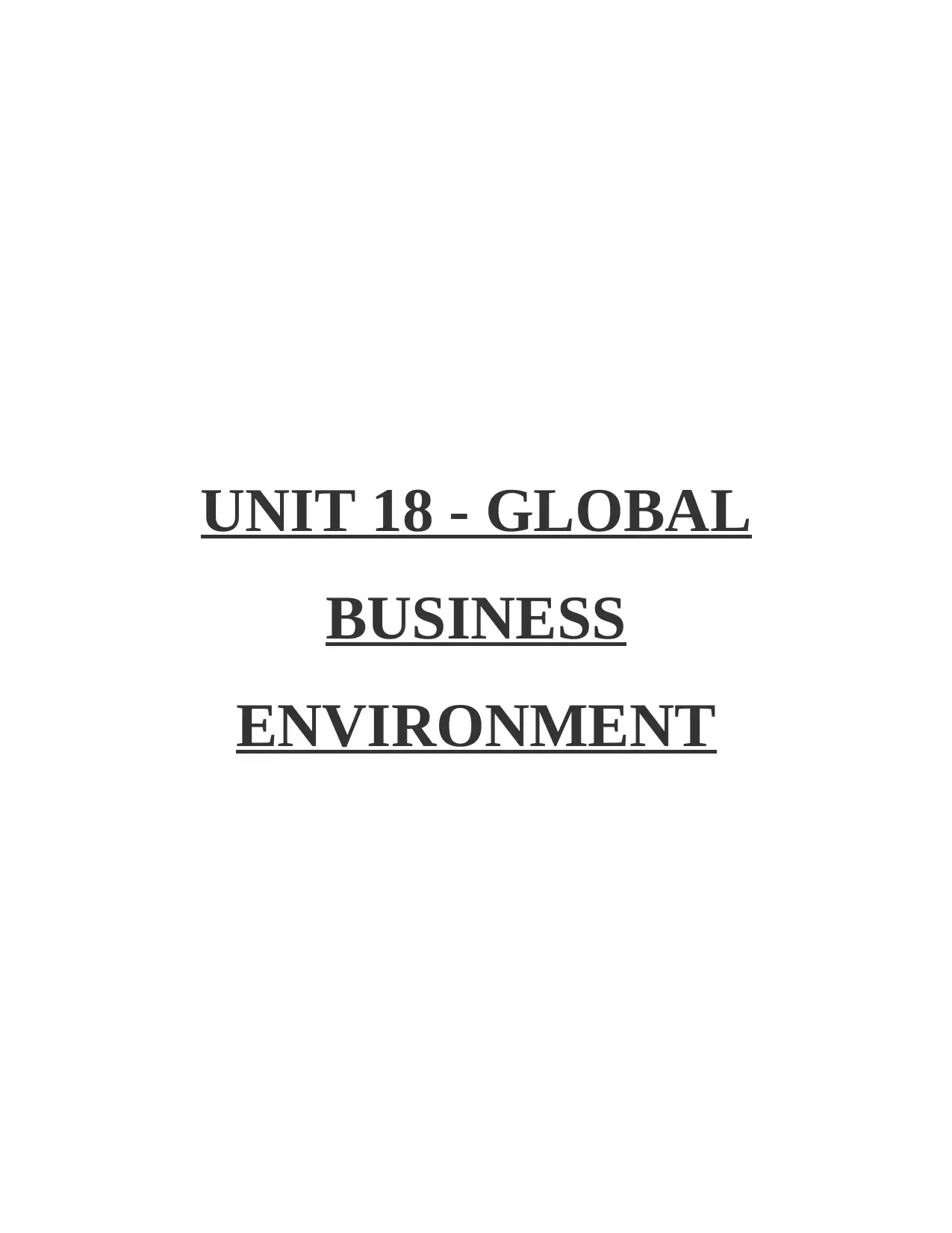
UNIT 18 - GLOBAL
BUSINESS
ENVIRONMENT
BUSINESS
ENVIRONMENT
Paraphrase This Document
Need a fresh take? Get an instant paraphrase of this document with our AI Paraphraser
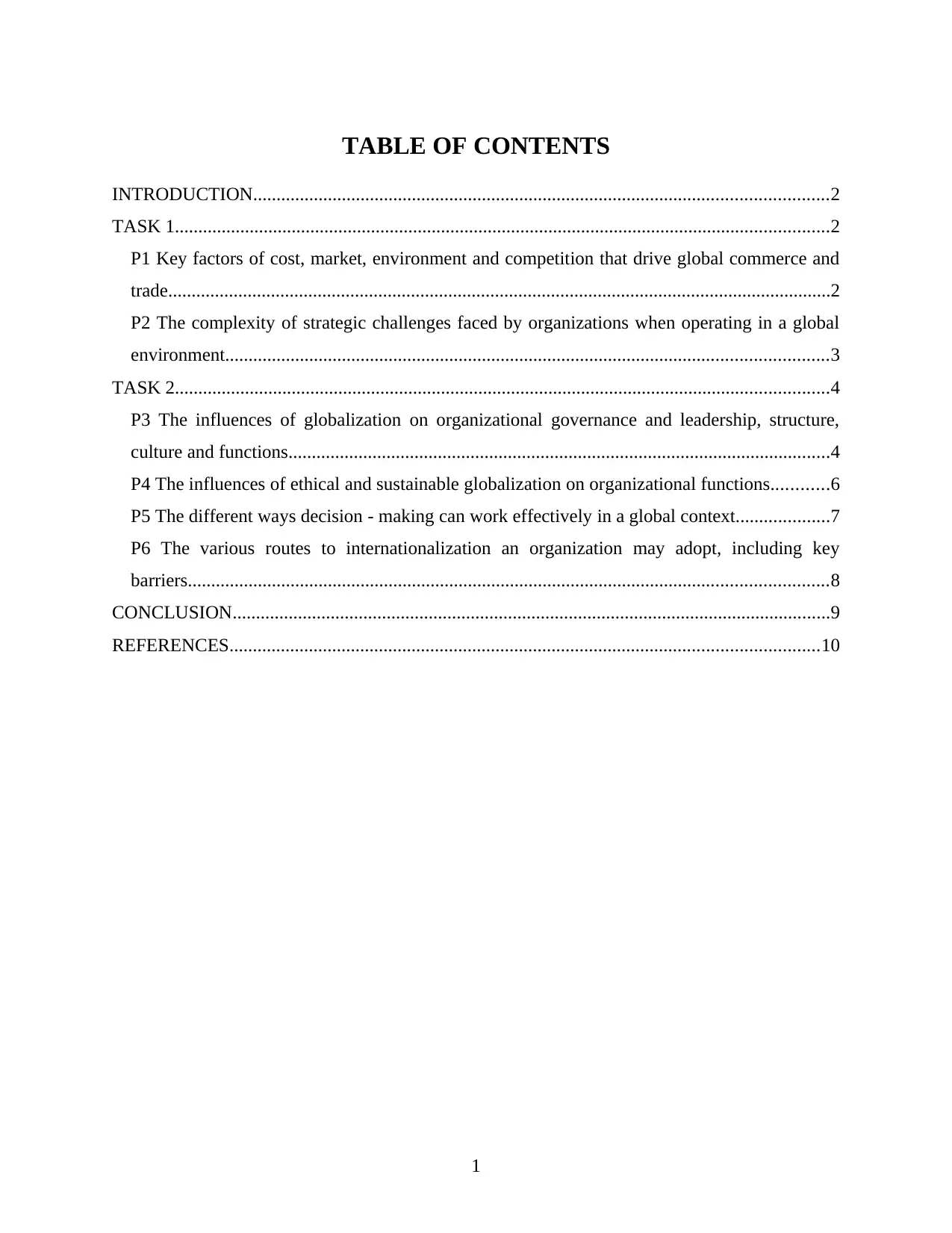
TABLE OF CONTENTS
INTRODUCTION...........................................................................................................................2
TASK 1............................................................................................................................................2
P1 Key factors of cost, market, environment and competition that drive global commerce and
trade..............................................................................................................................................2
P2 The complexity of strategic challenges faced by organizations when operating in a global
environment.................................................................................................................................3
TASK 2............................................................................................................................................4
P3 The influences of globalization on organizational governance and leadership, structure,
culture and functions....................................................................................................................4
P4 The influences of ethical and sustainable globalization on organizational functions............6
P5 The different ways decision - making can work effectively in a global context....................7
P6 The various routes to internationalization an organization may adopt, including key
barriers.........................................................................................................................................8
CONCLUSION................................................................................................................................9
REFERENCES..............................................................................................................................10
1
INTRODUCTION...........................................................................................................................2
TASK 1............................................................................................................................................2
P1 Key factors of cost, market, environment and competition that drive global commerce and
trade..............................................................................................................................................2
P2 The complexity of strategic challenges faced by organizations when operating in a global
environment.................................................................................................................................3
TASK 2............................................................................................................................................4
P3 The influences of globalization on organizational governance and leadership, structure,
culture and functions....................................................................................................................4
P4 The influences of ethical and sustainable globalization on organizational functions............6
P5 The different ways decision - making can work effectively in a global context....................7
P6 The various routes to internationalization an organization may adopt, including key
barriers.........................................................................................................................................8
CONCLUSION................................................................................................................................9
REFERENCES..............................................................................................................................10
1
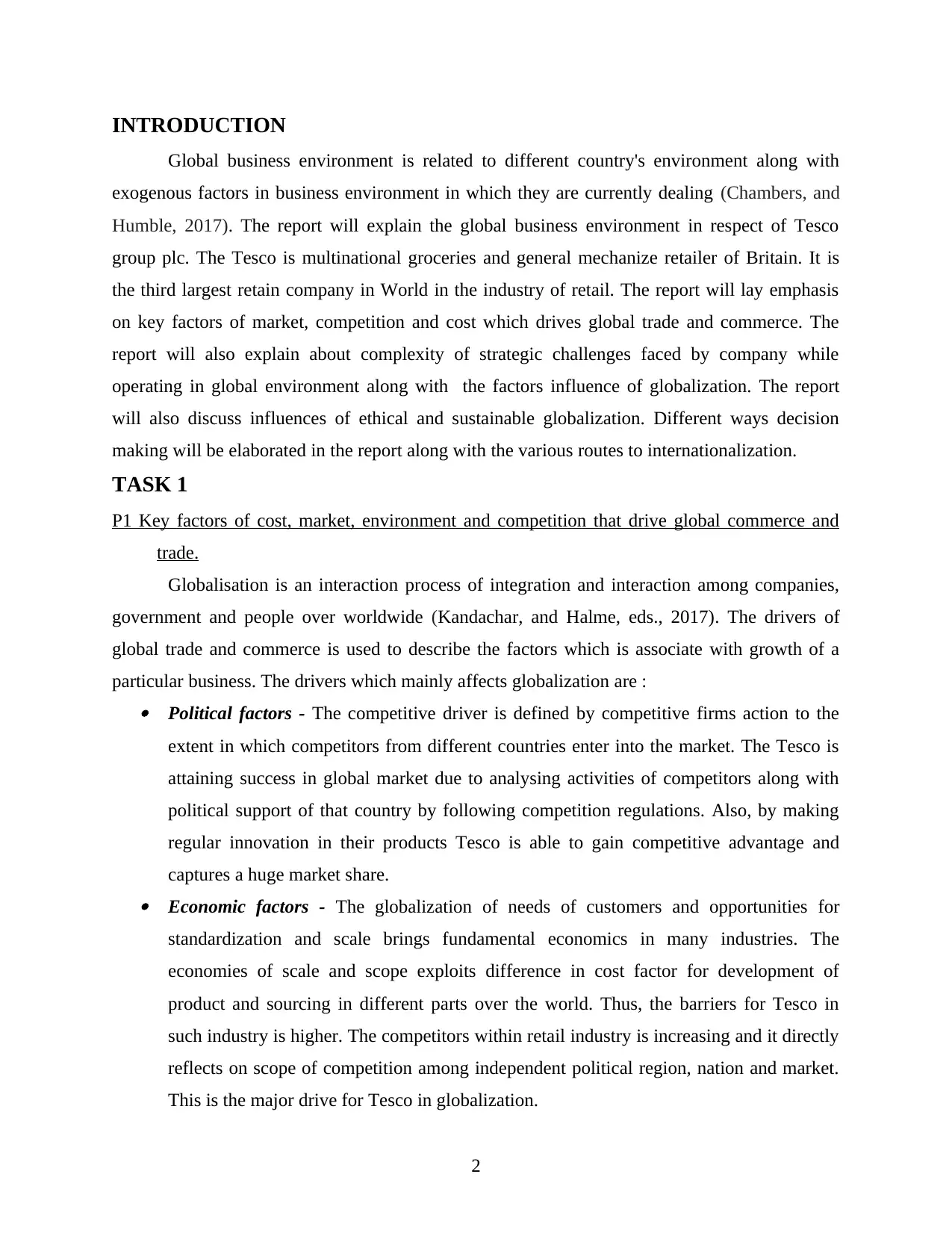
INTRODUCTION
Global business environment is related to different country's environment along with
exogenous factors in business environment in which they are currently dealing (Chambers, and
Humble, 2017). The report will explain the global business environment in respect of Tesco
group plc. The Tesco is multinational groceries and general mechanize retailer of Britain. It is
the third largest retain company in World in the industry of retail. The report will lay emphasis
on key factors of market, competition and cost which drives global trade and commerce. The
report will also explain about complexity of strategic challenges faced by company while
operating in global environment along with the factors influence of globalization. The report
will also discuss influences of ethical and sustainable globalization. Different ways decision
making will be elaborated in the report along with the various routes to internationalization.
TASK 1
P1 Key factors of cost, market, environment and competition that drive global commerce and
trade.
Globalisation is an interaction process of integration and interaction among companies,
government and people over worldwide (Kandachar, and Halme, eds., 2017). The drivers of
global trade and commerce is used to describe the factors which is associate with growth of a
particular business. The drivers which mainly affects globalization are : Political factors - The competitive driver is defined by competitive firms action to the
extent in which competitors from different countries enter into the market. The Tesco is
attaining success in global market due to analysing activities of competitors along with
political support of that country by following competition regulations. Also, by making
regular innovation in their products Tesco is able to gain competitive advantage and
captures a huge market share. Economic factors - The globalization of needs of customers and opportunities for
standardization and scale brings fundamental economics in many industries. The
economies of scale and scope exploits difference in cost factor for development of
product and sourcing in different parts over the world. Thus, the barriers for Tesco in
such industry is higher. The competitors within retail industry is increasing and it directly
reflects on scope of competition among independent political region, nation and market.
This is the major drive for Tesco in globalization.
2
Global business environment is related to different country's environment along with
exogenous factors in business environment in which they are currently dealing (Chambers, and
Humble, 2017). The report will explain the global business environment in respect of Tesco
group plc. The Tesco is multinational groceries and general mechanize retailer of Britain. It is
the third largest retain company in World in the industry of retail. The report will lay emphasis
on key factors of market, competition and cost which drives global trade and commerce. The
report will also explain about complexity of strategic challenges faced by company while
operating in global environment along with the factors influence of globalization. The report
will also discuss influences of ethical and sustainable globalization. Different ways decision
making will be elaborated in the report along with the various routes to internationalization.
TASK 1
P1 Key factors of cost, market, environment and competition that drive global commerce and
trade.
Globalisation is an interaction process of integration and interaction among companies,
government and people over worldwide (Kandachar, and Halme, eds., 2017). The drivers of
global trade and commerce is used to describe the factors which is associate with growth of a
particular business. The drivers which mainly affects globalization are : Political factors - The competitive driver is defined by competitive firms action to the
extent in which competitors from different countries enter into the market. The Tesco is
attaining success in global market due to analysing activities of competitors along with
political support of that country by following competition regulations. Also, by making
regular innovation in their products Tesco is able to gain competitive advantage and
captures a huge market share. Economic factors - The globalization of needs of customers and opportunities for
standardization and scale brings fundamental economics in many industries. The
economies of scale and scope exploits difference in cost factor for development of
product and sourcing in different parts over the world. Thus, the barriers for Tesco in
such industry is higher. The competitors within retail industry is increasing and it directly
reflects on scope of competition among independent political region, nation and market.
This is the major drive for Tesco in globalization.
2
⊘ This is a preview!⊘
Do you want full access?
Subscribe today to unlock all pages.

Trusted by 1+ million students worldwide
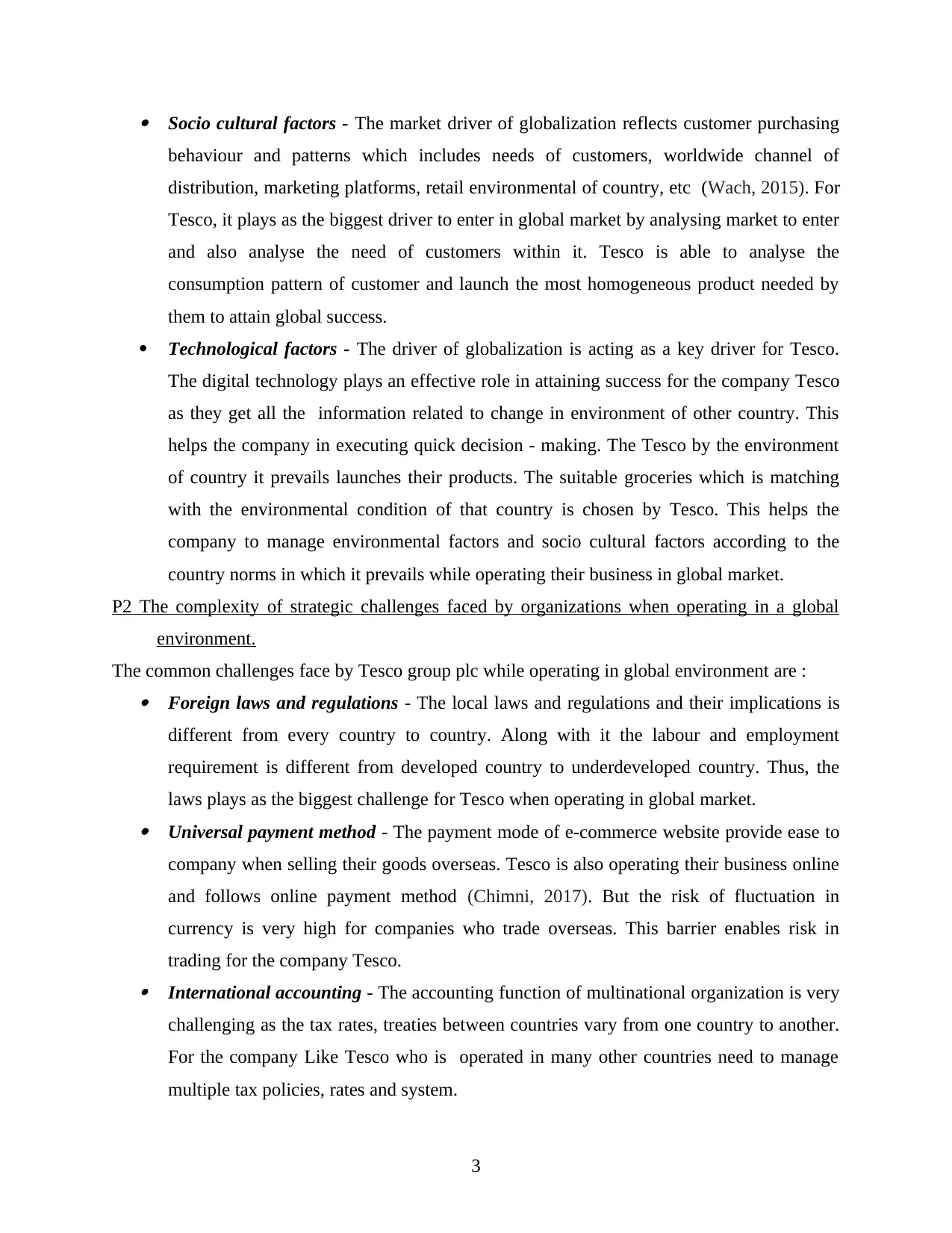
Socio cultural factors - The market driver of globalization reflects customer purchasing
behaviour and patterns which includes needs of customers, worldwide channel of
distribution, marketing platforms, retail environmental of country, etc (Wach, 2015). For
Tesco, it plays as the biggest driver to enter in global market by analysing market to enter
and also analyse the need of customers within it. Tesco is able to analyse the
consumption pattern of customer and launch the most homogeneous product needed by
them to attain global success.
Technological factors - The driver of globalization is acting as a key driver for Tesco.
The digital technology plays an effective role in attaining success for the company Tesco
as they get all the information related to change in environment of other country. This
helps the company in executing quick decision - making. The Tesco by the environment
of country it prevails launches their products. The suitable groceries which is matching
with the environmental condition of that country is chosen by Tesco. This helps the
company to manage environmental factors and socio cultural factors according to the
country norms in which it prevails while operating their business in global market.
P2 The complexity of strategic challenges faced by organizations when operating in a global
environment.
The common challenges face by Tesco group plc while operating in global environment are : Foreign laws and regulations - The local laws and regulations and their implications is
different from every country to country. Along with it the labour and employment
requirement is different from developed country to underdeveloped country. Thus, the
laws plays as the biggest challenge for Tesco when operating in global market. Universal payment method - The payment mode of e-commerce website provide ease to
company when selling their goods overseas. Tesco is also operating their business online
and follows online payment method (Chimni, 2017). But the risk of fluctuation in
currency is very high for companies who trade overseas. This barrier enables risk in
trading for the company Tesco. International accounting - The accounting function of multinational organization is very
challenging as the tax rates, treaties between countries vary from one country to another.
For the company Like Tesco who is operated in many other countries need to manage
multiple tax policies, rates and system.
3
behaviour and patterns which includes needs of customers, worldwide channel of
distribution, marketing platforms, retail environmental of country, etc (Wach, 2015). For
Tesco, it plays as the biggest driver to enter in global market by analysing market to enter
and also analyse the need of customers within it. Tesco is able to analyse the
consumption pattern of customer and launch the most homogeneous product needed by
them to attain global success.
Technological factors - The driver of globalization is acting as a key driver for Tesco.
The digital technology plays an effective role in attaining success for the company Tesco
as they get all the information related to change in environment of other country. This
helps the company in executing quick decision - making. The Tesco by the environment
of country it prevails launches their products. The suitable groceries which is matching
with the environmental condition of that country is chosen by Tesco. This helps the
company to manage environmental factors and socio cultural factors according to the
country norms in which it prevails while operating their business in global market.
P2 The complexity of strategic challenges faced by organizations when operating in a global
environment.
The common challenges face by Tesco group plc while operating in global environment are : Foreign laws and regulations - The local laws and regulations and their implications is
different from every country to country. Along with it the labour and employment
requirement is different from developed country to underdeveloped country. Thus, the
laws plays as the biggest challenge for Tesco when operating in global market. Universal payment method - The payment mode of e-commerce website provide ease to
company when selling their goods overseas. Tesco is also operating their business online
and follows online payment method (Chimni, 2017). But the risk of fluctuation in
currency is very high for companies who trade overseas. This barrier enables risk in
trading for the company Tesco. International accounting - The accounting function of multinational organization is very
challenging as the tax rates, treaties between countries vary from one country to another.
For the company Like Tesco who is operated in many other countries need to manage
multiple tax policies, rates and system.
3
Paraphrase This Document
Need a fresh take? Get an instant paraphrase of this document with our AI Paraphraser
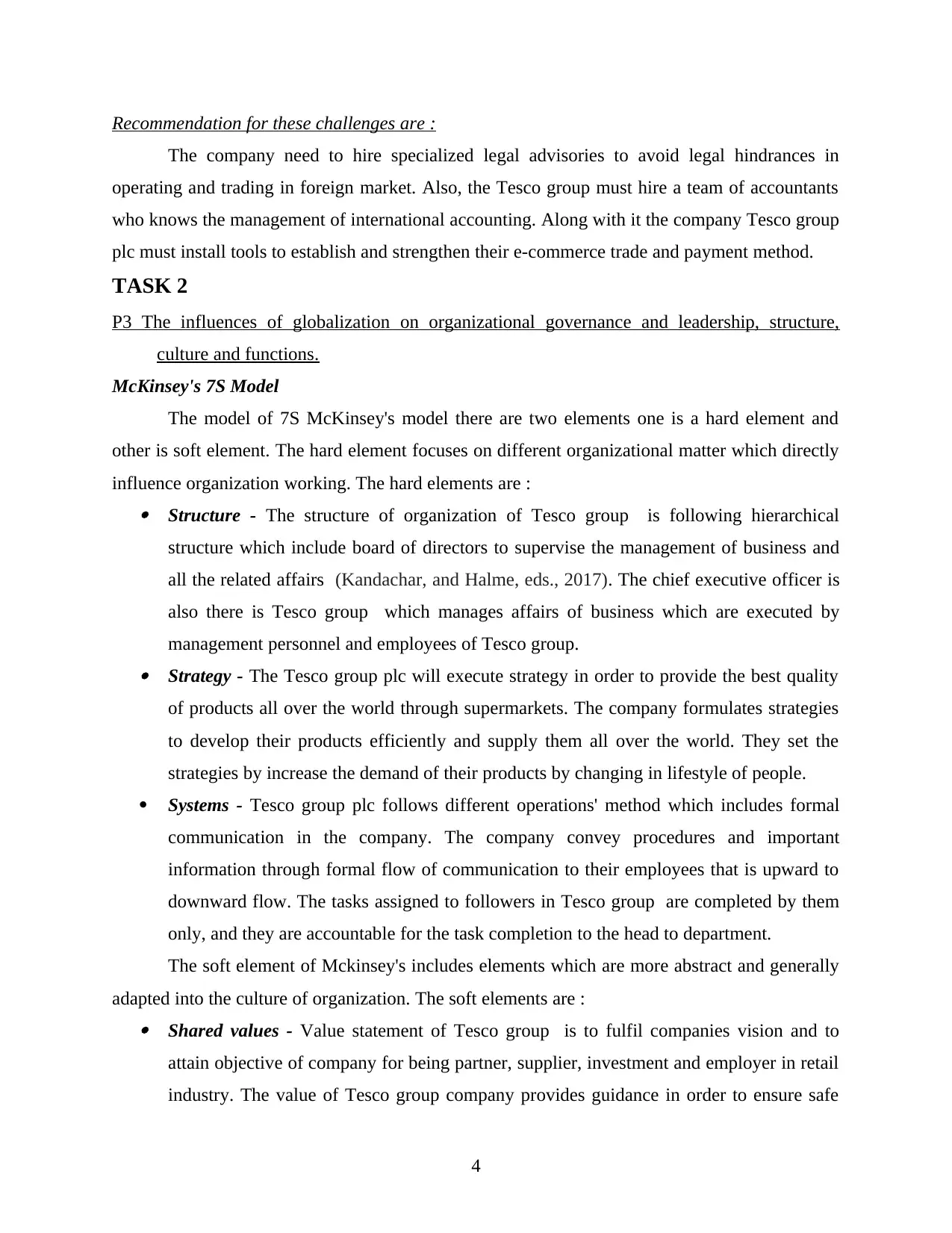
Recommendation for these challenges are :
The company need to hire specialized legal advisories to avoid legal hindrances in
operating and trading in foreign market. Also, the Tesco group must hire a team of accountants
who knows the management of international accounting. Along with it the company Tesco group
plc must install tools to establish and strengthen their e-commerce trade and payment method.
TASK 2
P3 The influences of globalization on organizational governance and leadership, structure,
culture and functions.
McKinsey's 7S Model
The model of 7S McKinsey's model there are two elements one is a hard element and
other is soft element. The hard element focuses on different organizational matter which directly
influence organization working. The hard elements are : Structure - The structure of organization of Tesco group is following hierarchical
structure which include board of directors to supervise the management of business and
all the related affairs (Kandachar, and Halme, eds., 2017). The chief executive officer is
also there is Tesco group which manages affairs of business which are executed by
management personnel and employees of Tesco group. Strategy - The Tesco group plc will execute strategy in order to provide the best quality
of products all over the world through supermarkets. The company formulates strategies
to develop their products efficiently and supply them all over the world. They set the
strategies by increase the demand of their products by changing in lifestyle of people.
Systems - Tesco group plc follows different operations' method which includes formal
communication in the company. The company convey procedures and important
information through formal flow of communication to their employees that is upward to
downward flow. The tasks assigned to followers in Tesco group are completed by them
only, and they are accountable for the task completion to the head to department.
The soft element of Mckinsey's includes elements which are more abstract and generally
adapted into the culture of organization. The soft elements are : Shared values - Value statement of Tesco group is to fulfil companies vision and to
attain objective of company for being partner, supplier, investment and employer in retail
industry. The value of Tesco group company provides guidance in order to ensure safe
4
The company need to hire specialized legal advisories to avoid legal hindrances in
operating and trading in foreign market. Also, the Tesco group must hire a team of accountants
who knows the management of international accounting. Along with it the company Tesco group
plc must install tools to establish and strengthen their e-commerce trade and payment method.
TASK 2
P3 The influences of globalization on organizational governance and leadership, structure,
culture and functions.
McKinsey's 7S Model
The model of 7S McKinsey's model there are two elements one is a hard element and
other is soft element. The hard element focuses on different organizational matter which directly
influence organization working. The hard elements are : Structure - The structure of organization of Tesco group is following hierarchical
structure which include board of directors to supervise the management of business and
all the related affairs (Kandachar, and Halme, eds., 2017). The chief executive officer is
also there is Tesco group which manages affairs of business which are executed by
management personnel and employees of Tesco group. Strategy - The Tesco group plc will execute strategy in order to provide the best quality
of products all over the world through supermarkets. The company formulates strategies
to develop their products efficiently and supply them all over the world. They set the
strategies by increase the demand of their products by changing in lifestyle of people.
Systems - Tesco group plc follows different operations' method which includes formal
communication in the company. The company convey procedures and important
information through formal flow of communication to their employees that is upward to
downward flow. The tasks assigned to followers in Tesco group are completed by them
only, and they are accountable for the task completion to the head to department.
The soft element of Mckinsey's includes elements which are more abstract and generally
adapted into the culture of organization. The soft elements are : Shared values - Value statement of Tesco group is to fulfil companies vision and to
attain objective of company for being partner, supplier, investment and employer in retail
industry. The value of Tesco group company provides guidance in order to ensure safe
4
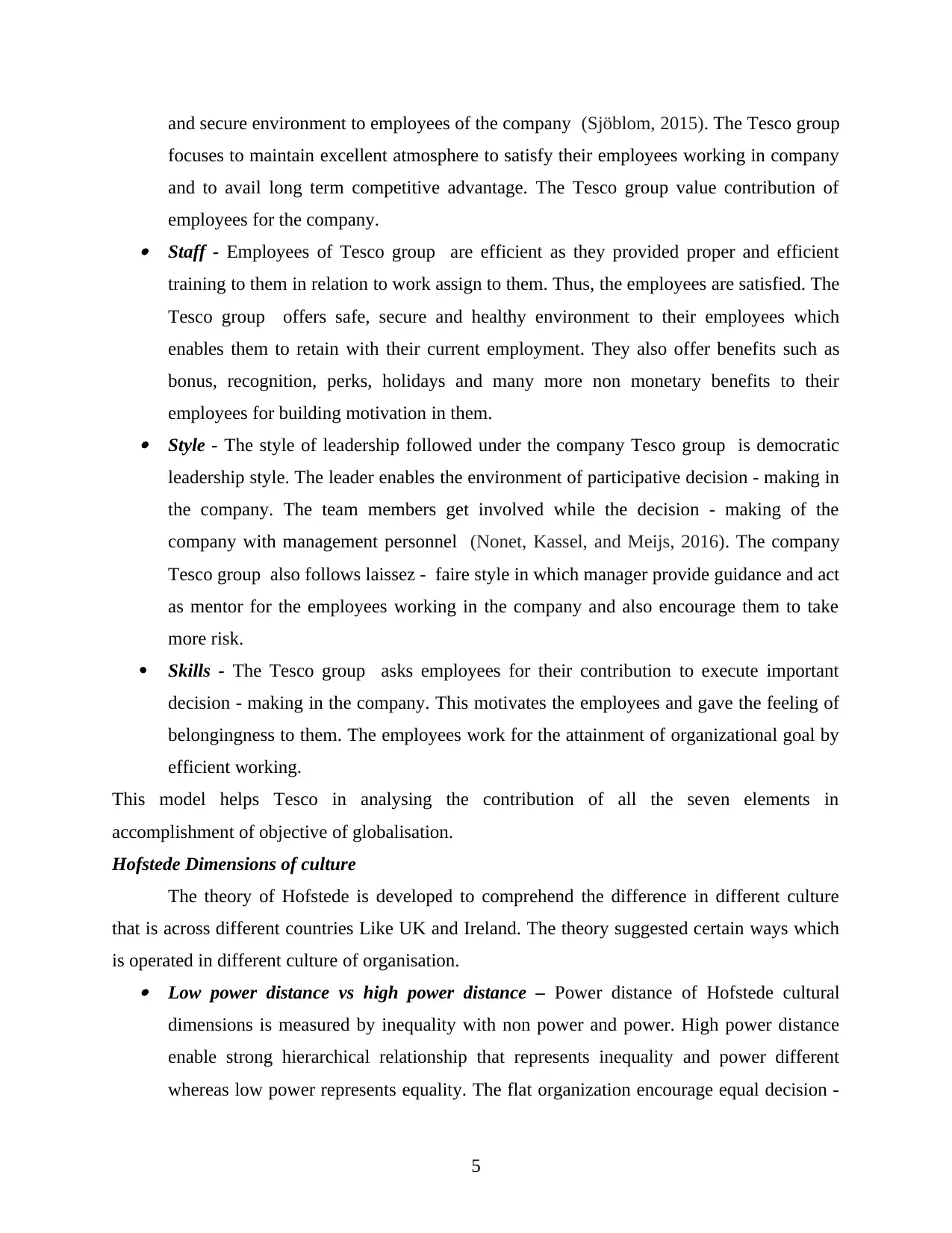
and secure environment to employees of the company (Sjöblom, 2015). The Tesco group
focuses to maintain excellent atmosphere to satisfy their employees working in company
and to avail long term competitive advantage. The Tesco group value contribution of
employees for the company. Staff - Employees of Tesco group are efficient as they provided proper and efficient
training to them in relation to work assign to them. Thus, the employees are satisfied. The
Tesco group offers safe, secure and healthy environment to their employees which
enables them to retain with their current employment. They also offer benefits such as
bonus, recognition, perks, holidays and many more non monetary benefits to their
employees for building motivation in them. Style - The style of leadership followed under the company Tesco group is democratic
leadership style. The leader enables the environment of participative decision - making in
the company. The team members get involved while the decision - making of the
company with management personnel (Nonet, Kassel, and Meijs, 2016). The company
Tesco group also follows laissez - faire style in which manager provide guidance and act
as mentor for the employees working in the company and also encourage them to take
more risk.
Skills - The Tesco group asks employees for their contribution to execute important
decision - making in the company. This motivates the employees and gave the feeling of
belongingness to them. The employees work for the attainment of organizational goal by
efficient working.
This model helps Tesco in analysing the contribution of all the seven elements in
accomplishment of objective of globalisation.
Hofstede Dimensions of culture
The theory of Hofstede is developed to comprehend the difference in different culture
that is across different countries Like UK and Ireland. The theory suggested certain ways which
is operated in different culture of organisation. Low power distance vs high power distance – Power distance of Hofstede cultural
dimensions is measured by inequality with non power and power. High power distance
enable strong hierarchical relationship that represents inequality and power different
whereas low power represents equality. The flat organization encourage equal decision -
5
focuses to maintain excellent atmosphere to satisfy their employees working in company
and to avail long term competitive advantage. The Tesco group value contribution of
employees for the company. Staff - Employees of Tesco group are efficient as they provided proper and efficient
training to them in relation to work assign to them. Thus, the employees are satisfied. The
Tesco group offers safe, secure and healthy environment to their employees which
enables them to retain with their current employment. They also offer benefits such as
bonus, recognition, perks, holidays and many more non monetary benefits to their
employees for building motivation in them. Style - The style of leadership followed under the company Tesco group is democratic
leadership style. The leader enables the environment of participative decision - making in
the company. The team members get involved while the decision - making of the
company with management personnel (Nonet, Kassel, and Meijs, 2016). The company
Tesco group also follows laissez - faire style in which manager provide guidance and act
as mentor for the employees working in the company and also encourage them to take
more risk.
Skills - The Tesco group asks employees for their contribution to execute important
decision - making in the company. This motivates the employees and gave the feeling of
belongingness to them. The employees work for the attainment of organizational goal by
efficient working.
This model helps Tesco in analysing the contribution of all the seven elements in
accomplishment of objective of globalisation.
Hofstede Dimensions of culture
The theory of Hofstede is developed to comprehend the difference in different culture
that is across different countries Like UK and Ireland. The theory suggested certain ways which
is operated in different culture of organisation. Low power distance vs high power distance – Power distance of Hofstede cultural
dimensions is measured by inequality with non power and power. High power distance
enable strong hierarchical relationship that represents inequality and power different
whereas low power represents equality. The flat organization encourage equal decision -
5
⊘ This is a preview!⊘
Do you want full access?
Subscribe today to unlock all pages.

Trusted by 1+ million students worldwide
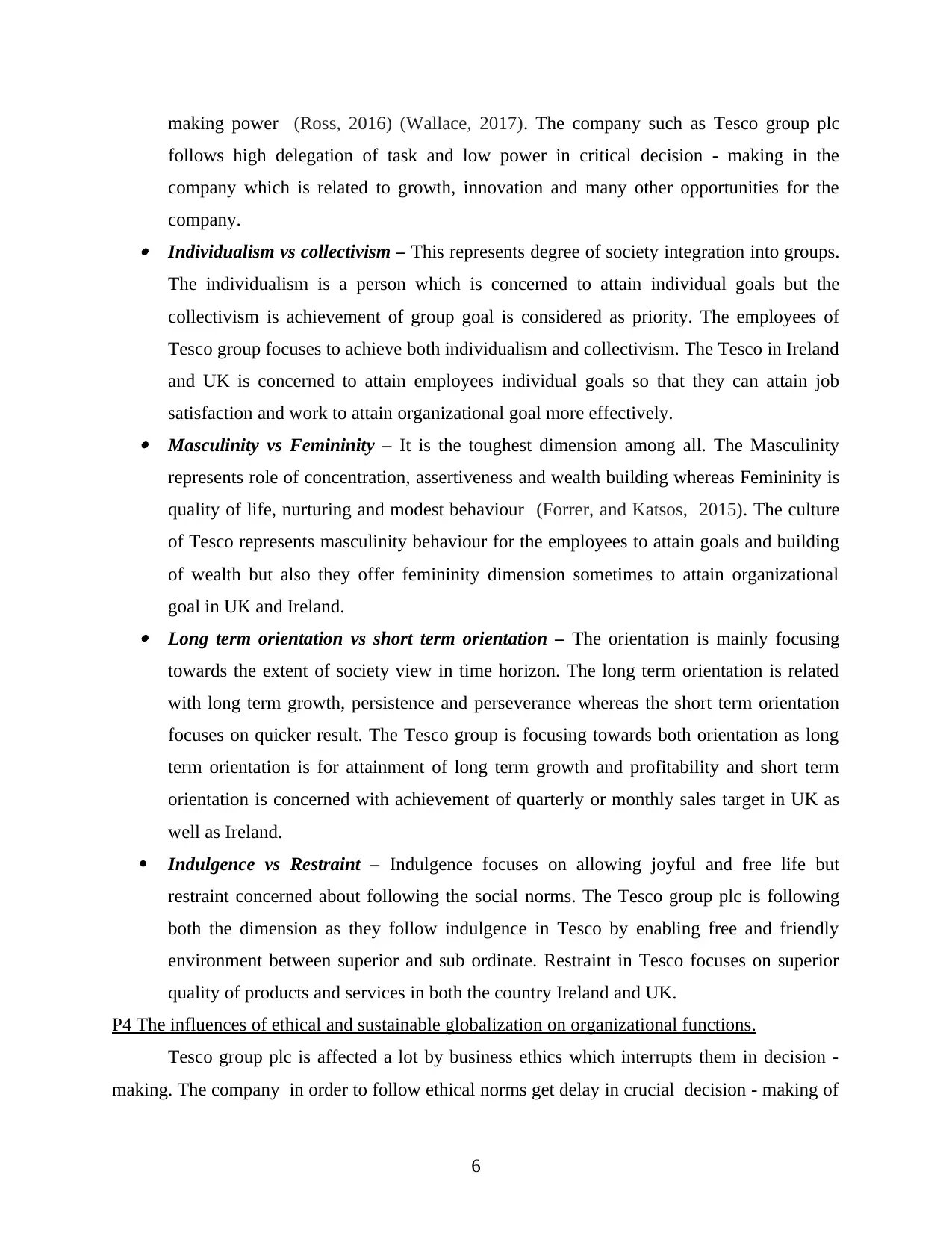
making power (Ross, 2016) (Wallace, 2017). The company such as Tesco group plc
follows high delegation of task and low power in critical decision - making in the
company which is related to growth, innovation and many other opportunities for the
company. Individualism vs collectivism – This represents degree of society integration into groups.
The individualism is a person which is concerned to attain individual goals but the
collectivism is achievement of group goal is considered as priority. The employees of
Tesco group focuses to achieve both individualism and collectivism. The Tesco in Ireland
and UK is concerned to attain employees individual goals so that they can attain job
satisfaction and work to attain organizational goal more effectively. Masculinity vs Femininity – It is the toughest dimension among all. The Masculinity
represents role of concentration, assertiveness and wealth building whereas Femininity is
quality of life, nurturing and modest behaviour (Forrer, and Katsos, 2015). The culture
of Tesco represents masculinity behaviour for the employees to attain goals and building
of wealth but also they offer femininity dimension sometimes to attain organizational
goal in UK and Ireland. Long term orientation vs short term orientation – The orientation is mainly focusing
towards the extent of society view in time horizon. The long term orientation is related
with long term growth, persistence and perseverance whereas the short term orientation
focuses on quicker result. The Tesco group is focusing towards both orientation as long
term orientation is for attainment of long term growth and profitability and short term
orientation is concerned with achievement of quarterly or monthly sales target in UK as
well as Ireland.
Indulgence vs Restraint – Indulgence focuses on allowing joyful and free life but
restraint concerned about following the social norms. The Tesco group plc is following
both the dimension as they follow indulgence in Tesco by enabling free and friendly
environment between superior and sub ordinate. Restraint in Tesco focuses on superior
quality of products and services in both the country Ireland and UK.
P4 The influences of ethical and sustainable globalization on organizational functions.
Tesco group plc is affected a lot by business ethics which interrupts them in decision -
making. The company in order to follow ethical norms get delay in crucial decision - making of
6
follows high delegation of task and low power in critical decision - making in the
company which is related to growth, innovation and many other opportunities for the
company. Individualism vs collectivism – This represents degree of society integration into groups.
The individualism is a person which is concerned to attain individual goals but the
collectivism is achievement of group goal is considered as priority. The employees of
Tesco group focuses to achieve both individualism and collectivism. The Tesco in Ireland
and UK is concerned to attain employees individual goals so that they can attain job
satisfaction and work to attain organizational goal more effectively. Masculinity vs Femininity – It is the toughest dimension among all. The Masculinity
represents role of concentration, assertiveness and wealth building whereas Femininity is
quality of life, nurturing and modest behaviour (Forrer, and Katsos, 2015). The culture
of Tesco represents masculinity behaviour for the employees to attain goals and building
of wealth but also they offer femininity dimension sometimes to attain organizational
goal in UK and Ireland. Long term orientation vs short term orientation – The orientation is mainly focusing
towards the extent of society view in time horizon. The long term orientation is related
with long term growth, persistence and perseverance whereas the short term orientation
focuses on quicker result. The Tesco group is focusing towards both orientation as long
term orientation is for attainment of long term growth and profitability and short term
orientation is concerned with achievement of quarterly or monthly sales target in UK as
well as Ireland.
Indulgence vs Restraint – Indulgence focuses on allowing joyful and free life but
restraint concerned about following the social norms. The Tesco group plc is following
both the dimension as they follow indulgence in Tesco by enabling free and friendly
environment between superior and sub ordinate. Restraint in Tesco focuses on superior
quality of products and services in both the country Ireland and UK.
P4 The influences of ethical and sustainable globalization on organizational functions.
Tesco group plc is affected a lot by business ethics which interrupts them in decision -
making. The company in order to follow ethical norms get delay in crucial decision - making of
6
Paraphrase This Document
Need a fresh take? Get an instant paraphrase of this document with our AI Paraphraser
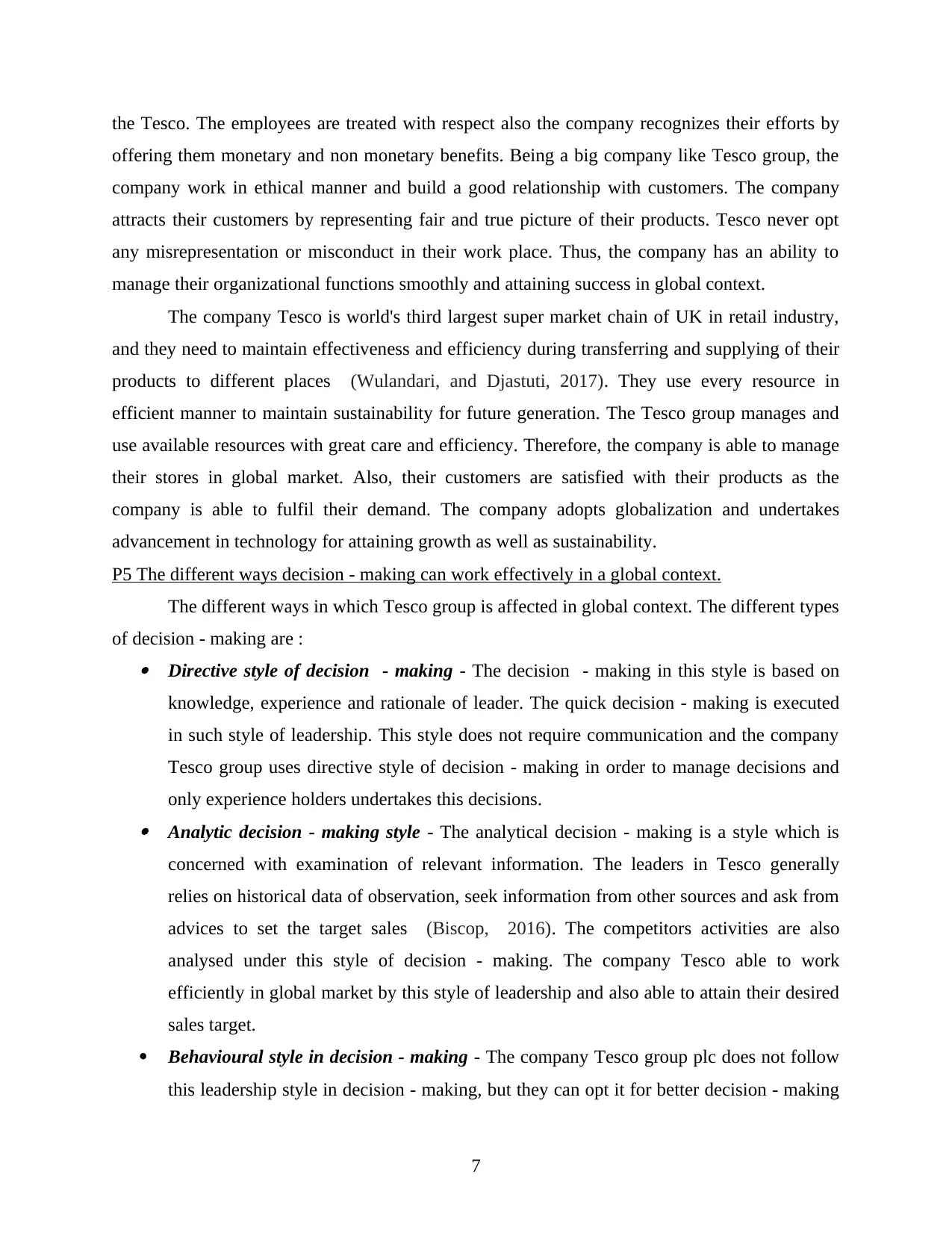
the Tesco. The employees are treated with respect also the company recognizes their efforts by
offering them monetary and non monetary benefits. Being a big company like Tesco group, the
company work in ethical manner and build a good relationship with customers. The company
attracts their customers by representing fair and true picture of their products. Tesco never opt
any misrepresentation or misconduct in their work place. Thus, the company has an ability to
manage their organizational functions smoothly and attaining success in global context.
The company Tesco is world's third largest super market chain of UK in retail industry,
and they need to maintain effectiveness and efficiency during transferring and supplying of their
products to different places (Wulandari, and Djastuti, 2017). They use every resource in
efficient manner to maintain sustainability for future generation. The Tesco group manages and
use available resources with great care and efficiency. Therefore, the company is able to manage
their stores in global market. Also, their customers are satisfied with their products as the
company is able to fulfil their demand. The company adopts globalization and undertakes
advancement in technology for attaining growth as well as sustainability.
P5 The different ways decision - making can work effectively in a global context.
The different ways in which Tesco group is affected in global context. The different types
of decision - making are : Directive style of decision - making - The decision - making in this style is based on
knowledge, experience and rationale of leader. The quick decision - making is executed
in such style of leadership. This style does not require communication and the company
Tesco group uses directive style of decision - making in order to manage decisions and
only experience holders undertakes this decisions. Analytic decision - making style - The analytical decision - making is a style which is
concerned with examination of relevant information. The leaders in Tesco generally
relies on historical data of observation, seek information from other sources and ask from
advices to set the target sales (Biscop, 2016). The competitors activities are also
analysed under this style of decision - making. The company Tesco able to work
efficiently in global market by this style of leadership and also able to attain their desired
sales target.
Behavioural style in decision - making - The company Tesco group plc does not follow
this leadership style in decision - making, but they can opt it for better decision - making
7
offering them monetary and non monetary benefits. Being a big company like Tesco group, the
company work in ethical manner and build a good relationship with customers. The company
attracts their customers by representing fair and true picture of their products. Tesco never opt
any misrepresentation or misconduct in their work place. Thus, the company has an ability to
manage their organizational functions smoothly and attaining success in global context.
The company Tesco is world's third largest super market chain of UK in retail industry,
and they need to maintain effectiveness and efficiency during transferring and supplying of their
products to different places (Wulandari, and Djastuti, 2017). They use every resource in
efficient manner to maintain sustainability for future generation. The Tesco group manages and
use available resources with great care and efficiency. Therefore, the company is able to manage
their stores in global market. Also, their customers are satisfied with their products as the
company is able to fulfil their demand. The company adopts globalization and undertakes
advancement in technology for attaining growth as well as sustainability.
P5 The different ways decision - making can work effectively in a global context.
The different ways in which Tesco group is affected in global context. The different types
of decision - making are : Directive style of decision - making - The decision - making in this style is based on
knowledge, experience and rationale of leader. The quick decision - making is executed
in such style of leadership. This style does not require communication and the company
Tesco group uses directive style of decision - making in order to manage decisions and
only experience holders undertakes this decisions. Analytic decision - making style - The analytical decision - making is a style which is
concerned with examination of relevant information. The leaders in Tesco generally
relies on historical data of observation, seek information from other sources and ask from
advices to set the target sales (Biscop, 2016). The competitors activities are also
analysed under this style of decision - making. The company Tesco able to work
efficiently in global market by this style of leadership and also able to attain their desired
sales target.
Behavioural style in decision - making - The company Tesco group plc does not follow
this leadership style in decision - making, but they can opt it for better decision - making
7
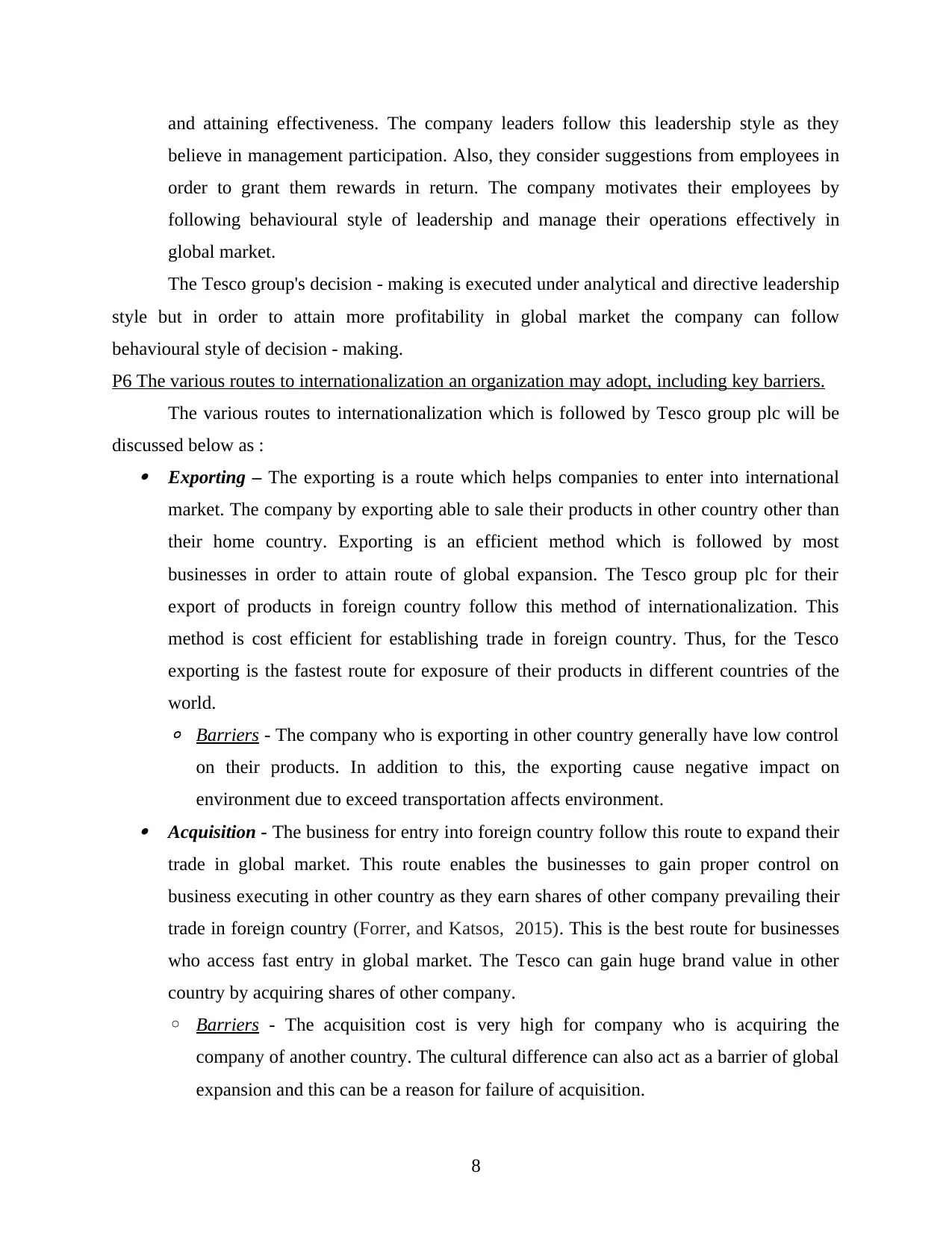
and attaining effectiveness. The company leaders follow this leadership style as they
believe in management participation. Also, they consider suggestions from employees in
order to grant them rewards in return. The company motivates their employees by
following behavioural style of leadership and manage their operations effectively in
global market.
The Tesco group's decision - making is executed under analytical and directive leadership
style but in order to attain more profitability in global market the company can follow
behavioural style of decision - making.
P6 The various routes to internationalization an organization may adopt, including key barriers.
The various routes to internationalization which is followed by Tesco group plc will be
discussed below as : Exporting – The exporting is a route which helps companies to enter into international
market. The company by exporting able to sale their products in other country other than
their home country. Exporting is an efficient method which is followed by most
businesses in order to attain route of global expansion. The Tesco group plc for their
export of products in foreign country follow this method of internationalization. This
method is cost efficient for establishing trade in foreign country. Thus, for the Tesco
exporting is the fastest route for exposure of their products in different countries of the
world.
◦ Barriers - The company who is exporting in other country generally have low control
on their products. In addition to this, the exporting cause negative impact on
environment due to exceed transportation affects environment. Acquisition - The business for entry into foreign country follow this route to expand their
trade in global market. This route enables the businesses to gain proper control on
business executing in other country as they earn shares of other company prevailing their
trade in foreign country (Forrer, and Katsos, 2015). This is the best route for businesses
who access fast entry in global market. The Tesco can gain huge brand value in other
country by acquiring shares of other company.
◦ Barriers - The acquisition cost is very high for company who is acquiring the
company of another country. The cultural difference can also act as a barrier of global
expansion and this can be a reason for failure of acquisition.
8
believe in management participation. Also, they consider suggestions from employees in
order to grant them rewards in return. The company motivates their employees by
following behavioural style of leadership and manage their operations effectively in
global market.
The Tesco group's decision - making is executed under analytical and directive leadership
style but in order to attain more profitability in global market the company can follow
behavioural style of decision - making.
P6 The various routes to internationalization an organization may adopt, including key barriers.
The various routes to internationalization which is followed by Tesco group plc will be
discussed below as : Exporting – The exporting is a route which helps companies to enter into international
market. The company by exporting able to sale their products in other country other than
their home country. Exporting is an efficient method which is followed by most
businesses in order to attain route of global expansion. The Tesco group plc for their
export of products in foreign country follow this method of internationalization. This
method is cost efficient for establishing trade in foreign country. Thus, for the Tesco
exporting is the fastest route for exposure of their products in different countries of the
world.
◦ Barriers - The company who is exporting in other country generally have low control
on their products. In addition to this, the exporting cause negative impact on
environment due to exceed transportation affects environment. Acquisition - The business for entry into foreign country follow this route to expand their
trade in global market. This route enables the businesses to gain proper control on
business executing in other country as they earn shares of other company prevailing their
trade in foreign country (Forrer, and Katsos, 2015). This is the best route for businesses
who access fast entry in global market. The Tesco can gain huge brand value in other
country by acquiring shares of other company.
◦ Barriers - The acquisition cost is very high for company who is acquiring the
company of another country. The cultural difference can also act as a barrier of global
expansion and this can be a reason for failure of acquisition.
8
⊘ This is a preview!⊘
Do you want full access?
Subscribe today to unlock all pages.

Trusted by 1+ million students worldwide
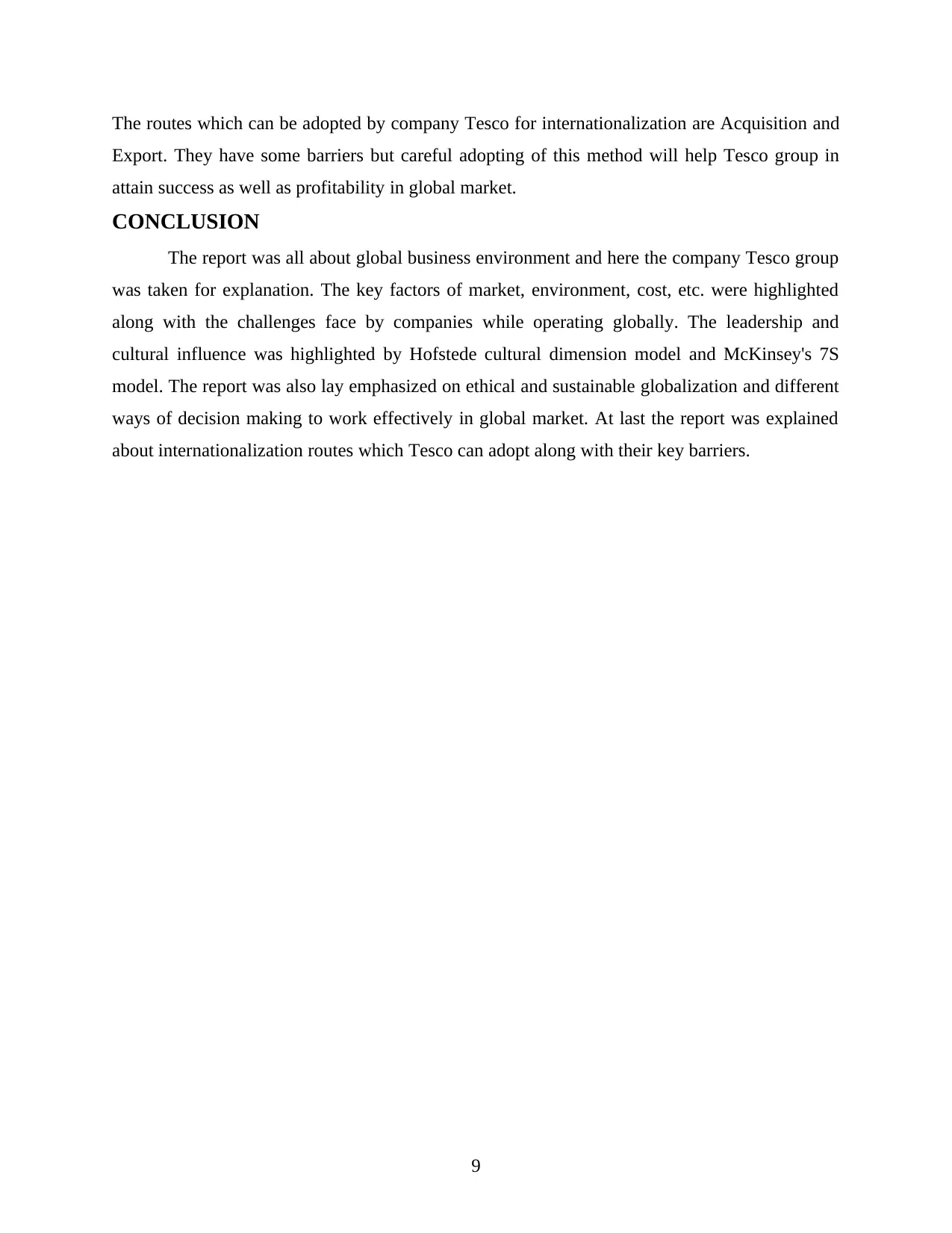
The routes which can be adopted by company Tesco for internationalization are Acquisition and
Export. They have some barriers but careful adopting of this method will help Tesco group in
attain success as well as profitability in global market.
CONCLUSION
The report was all about global business environment and here the company Tesco group
was taken for explanation. The key factors of market, environment, cost, etc. were highlighted
along with the challenges face by companies while operating globally. The leadership and
cultural influence was highlighted by Hofstede cultural dimension model and McKinsey's 7S
model. The report was also lay emphasized on ethical and sustainable globalization and different
ways of decision making to work effectively in global market. At last the report was explained
about internationalization routes which Tesco can adopt along with their key barriers.
9
Export. They have some barriers but careful adopting of this method will help Tesco group in
attain success as well as profitability in global market.
CONCLUSION
The report was all about global business environment and here the company Tesco group
was taken for explanation. The key factors of market, environment, cost, etc. were highlighted
along with the challenges face by companies while operating globally. The leadership and
cultural influence was highlighted by Hofstede cultural dimension model and McKinsey's 7S
model. The report was also lay emphasized on ethical and sustainable globalization and different
ways of decision making to work effectively in global market. At last the report was explained
about internationalization routes which Tesco can adopt along with their key barriers.
9
Paraphrase This Document
Need a fresh take? Get an instant paraphrase of this document with our AI Paraphraser
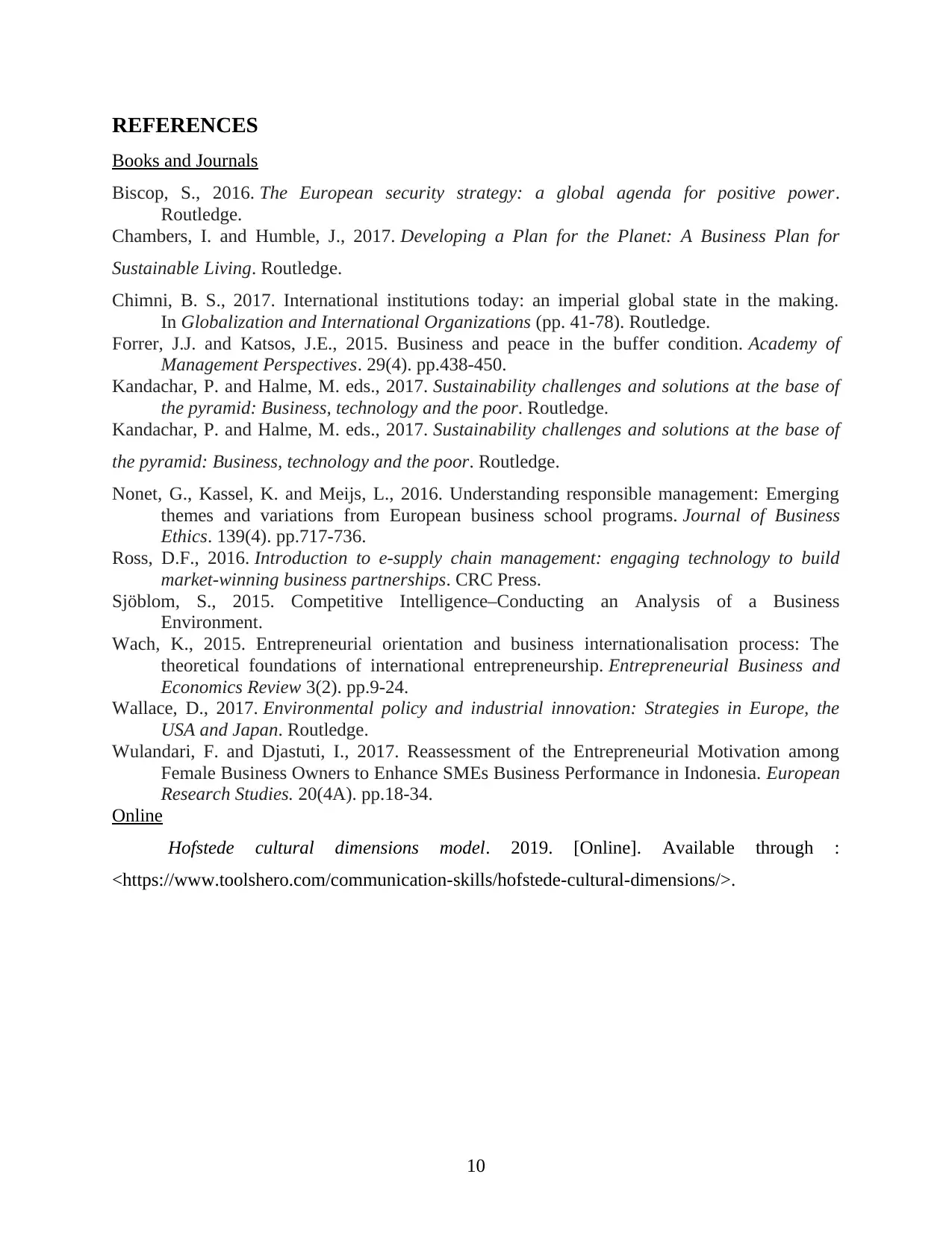
REFERENCES
Books and Journals
Biscop, S., 2016. The European security strategy: a global agenda for positive power.
Routledge.
Chambers, I. and Humble, J., 2017. Developing a Plan for the Planet: A Business Plan for
Sustainable Living. Routledge.
Chimni, B. S., 2017. International institutions today: an imperial global state in the making.
In Globalization and International Organizations (pp. 41-78). Routledge.
Forrer, J.J. and Katsos, J.E., 2015. Business and peace in the buffer condition. Academy of
Management Perspectives. 29(4). pp.438-450.
Kandachar, P. and Halme, M. eds., 2017. Sustainability challenges and solutions at the base of
the pyramid: Business, technology and the poor. Routledge.
Kandachar, P. and Halme, M. eds., 2017. Sustainability challenges and solutions at the base of
the pyramid: Business, technology and the poor. Routledge.
Nonet, G., Kassel, K. and Meijs, L., 2016. Understanding responsible management: Emerging
themes and variations from European business school programs. Journal of Business
Ethics. 139(4). pp.717-736.
Ross, D.F., 2016. Introduction to e-supply chain management: engaging technology to build
market-winning business partnerships. CRC Press.
Sjöblom, S., 2015. Competitive Intelligence–Conducting an Analysis of a Business
Environment.
Wach, K., 2015. Entrepreneurial orientation and business internationalisation process: The
theoretical foundations of international entrepreneurship. Entrepreneurial Business and
Economics Review 3(2). pp.9-24.
Wallace, D., 2017. Environmental policy and industrial innovation: Strategies in Europe, the
USA and Japan. Routledge.
Wulandari, F. and Djastuti, I., 2017. Reassessment of the Entrepreneurial Motivation among
Female Business Owners to Enhance SMEs Business Performance in Indonesia. European
Research Studies. 20(4A). pp.18-34.
Online
Hofstede cultural dimensions model. 2019. [Online]. Available through :
<https://www.toolshero.com/communication-skills/hofstede-cultural-dimensions/>.
10
Books and Journals
Biscop, S., 2016. The European security strategy: a global agenda for positive power.
Routledge.
Chambers, I. and Humble, J., 2017. Developing a Plan for the Planet: A Business Plan for
Sustainable Living. Routledge.
Chimni, B. S., 2017. International institutions today: an imperial global state in the making.
In Globalization and International Organizations (pp. 41-78). Routledge.
Forrer, J.J. and Katsos, J.E., 2015. Business and peace in the buffer condition. Academy of
Management Perspectives. 29(4). pp.438-450.
Kandachar, P. and Halme, M. eds., 2017. Sustainability challenges and solutions at the base of
the pyramid: Business, technology and the poor. Routledge.
Kandachar, P. and Halme, M. eds., 2017. Sustainability challenges and solutions at the base of
the pyramid: Business, technology and the poor. Routledge.
Nonet, G., Kassel, K. and Meijs, L., 2016. Understanding responsible management: Emerging
themes and variations from European business school programs. Journal of Business
Ethics. 139(4). pp.717-736.
Ross, D.F., 2016. Introduction to e-supply chain management: engaging technology to build
market-winning business partnerships. CRC Press.
Sjöblom, S., 2015. Competitive Intelligence–Conducting an Analysis of a Business
Environment.
Wach, K., 2015. Entrepreneurial orientation and business internationalisation process: The
theoretical foundations of international entrepreneurship. Entrepreneurial Business and
Economics Review 3(2). pp.9-24.
Wallace, D., 2017. Environmental policy and industrial innovation: Strategies in Europe, the
USA and Japan. Routledge.
Wulandari, F. and Djastuti, I., 2017. Reassessment of the Entrepreneurial Motivation among
Female Business Owners to Enhance SMEs Business Performance in Indonesia. European
Research Studies. 20(4A). pp.18-34.
Online
Hofstede cultural dimensions model. 2019. [Online]. Available through :
<https://www.toolshero.com/communication-skills/hofstede-cultural-dimensions/>.
10
1 out of 11
Related Documents
Your All-in-One AI-Powered Toolkit for Academic Success.
+13062052269
info@desklib.com
Available 24*7 on WhatsApp / Email
![[object Object]](/_next/static/media/star-bottom.7253800d.svg)
Unlock your academic potential
Copyright © 2020–2025 A2Z Services. All Rights Reserved. Developed and managed by ZUCOL.



